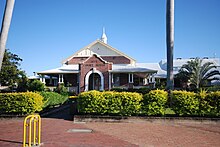피루피
Pi Lupi| 관측자료 에포크 J2000 이쿼녹스 J2000 | |
|---|---|
| 콘스텔레이션 | 루푸스 |
| 우등승 | 15h 05m 07.08596s[2] |
| 점괘 | -47° 03' 04.4976 |
| 겉보기 등급(V) | 3.89[3] |
| 특성. | |
| 분광형 | B5V + B5IV[4] |
| U-B 색지수 | −0.59[3] |
| B-V 컬러 인덱스 | −0.14[3] |
| 측성학 | |
| 반지름 속도(Rv) | +4.50[5] km/s |
| 고유운동(μ) | RA: -22.98[2] mas/year Dec.: -22.81[2] mas/year |
| 시차(π) | 7.36 ± 0.55 mas[2] |
| 거리 | 440 ± 30 ly (140 ± 10pc) |
| 세부 사항 | |
| A | |
| 덩어리 | 4.5[6] M☉ |
| 표면중력(logg) | 4.5[6] cgs |
| 온도 | 16,000K[6] |
| 회전속도(vsini) | 초속 10km[6] |
| B | |
| 덩어리 | 4.7[6] M☉ |
| 온도 | 14,000K[6] |
| 회전속도(vsini) | 초속 10km[6] |
| 나이 | 14[6] Myr |
| 기타지명 | |
| π 루피 A: HD 133242, HR 5605 | |
| π 루피 B: HD 133243, HR 5606 | |
| 데이터베이스 참조 | |
| 심배드 | 데이터. |
| A | |
| B | |
π 루피(Lupi, 라틴어로 Pi Lupi)는 루푸스자리 남쪽에 있는 다중성계입니다.두 구성 요소는 공전 주기가 517년이고 장축 반지름이 1.59 ″인 넓은 쌍성 쌍을 형성합니다.이들은 스코-센 복합체의 상부 센타우루스자리 루푸스 성분에 속합니다.[4]
적어도 구성 요소 중 하나는 분광쌍성으로 15.5일 간격으로 일식을 일으켜 일식쌍성이 됩니다.천천히 맥동하는 B형 항성의 맥동일 가능성이 높은 16시간 주기의 다른 밝기 변화도 있습니다.일식은 밝기가 1% 또는 약 0.01 등급 정도로 낮아지며 얕습니다.맥동의 진폭은 훨씬 더 작습니다.[1]
π 루피 A(HR 5605, HD 133242)는 적어도 두 개의 연구에 의해 분광쌍성으로 분류되었지만, 두 구성 요소 모두 분광쌍성일 가능성이 있습니다.
참고문헌
- ^ a b Sharma, Awshesh N.; Bedding, Timothy R.; Saio, Hideyuki; White, Timothy R. (2022), "Pulsating B stars in the Scorpius–Centaurus Association with TESS", Monthly Notices of the Royal Astronomical Society, 515 (1): 828–840, arXiv:2203.02582, Bibcode:2022MNRAS.515..828S, doi:10.1093/mnras/stac1816
- ^ a b c d e van Leeuwen, F. (2007), "Validation of the new Hipparcos reduction", Astronomy and Astrophysics, 474 (2): 653–664, arXiv:0708.1752, Bibcode:2007A&A...474..653V, doi:10.1051/0004-6361:20078357, S2CID 18759600Vizier 카탈로그 항목
- ^ a b c Nicolet, B. (1978), "Photoelectric photometric Catalogue of homogeneous measurements in the UBV System", Astronomy and Astrophysics Supplement Series, 34: 1–49, Bibcode:1978A&AS...34....1N
- ^ a b Nitschelm, C. (December 2004), Hilditch, R. W.; Hensberge, H.; Pavlovski, K. (eds.), "Discovery and confirmation of some double-lined spectroscopic binaries in the Sco-Cen Complex", Spectroscopically and Spatially Resolving the Components of the Close Binary Stars, Proceedings of the Workshop held 20–24 October 2003 in Dubrovnik, Croatia., ASP Conference Series, Astronomical Society of the Pacific, vol. 318, pp. 291–293, Bibcode:2004ASPC..318..291N
- ^ Kharchenko, N. V.; et al. (2007), "Astrophysical supplements to the ASCC-2.5: Ia. Radial velocities of ˜55000 stars and mean radial velocities of 516 Galactic open clusters and associations", Astronomische Nachrichten, 328 (9): 889–896, arXiv:0705.0878, Bibcode:2007AN....328..889K, doi:10.1002/asna.200710776, S2CID 119323941
- ^ a b c d e f g h Gullikson, Kevin; Kraus, Adam; Dodson-Robinson, Sarah (25 July 2016), "The Close Companion Mass-ratio Distribution of Intermediate-mass Stars", The Astronomical Journal, 152 (2): 40, arXiv:1604.06456, Bibcode:2016AJ....152...40G, doi:10.3847/0004-6256/152/2/40, eISSN 1538-3881
- ^ Buscombe, W.; Stoeckley, T. R. (1975), "Absorption Line Profiles and Rotational Velocities for 59 Stars", Astrophysics and Space Science, 37 (1): 197, Bibcode:1975Ap&SS..37..197B, doi:10.1007/BF00646073, S2CID 122985118
- ^ Chini, R.; Hoffmeister, V. H.; Nasseri, A.; Stahl, O.; Zinnecker, H. (2012), "A spectroscopic survey on the multiplicity of high-mass stars", Monthly Notices of the Royal Astronomical Society, 424 (3): 1925, arXiv:1205.5238, Bibcode:2012MNRAS.424.1925C, doi:10.1111/j.1365-2966.2012.21317.x, S2CID 119120749
- ^ Mason, Brian D.; et al. (December 2001), "The 2001 US Naval Observatory Double Star CD-ROM. I. The Washington Double Star Catalog", The Astronomical Journal, 122 (6): 3466–3471, Bibcode:2001AJ....122.3466M, doi:10.1086/323920


